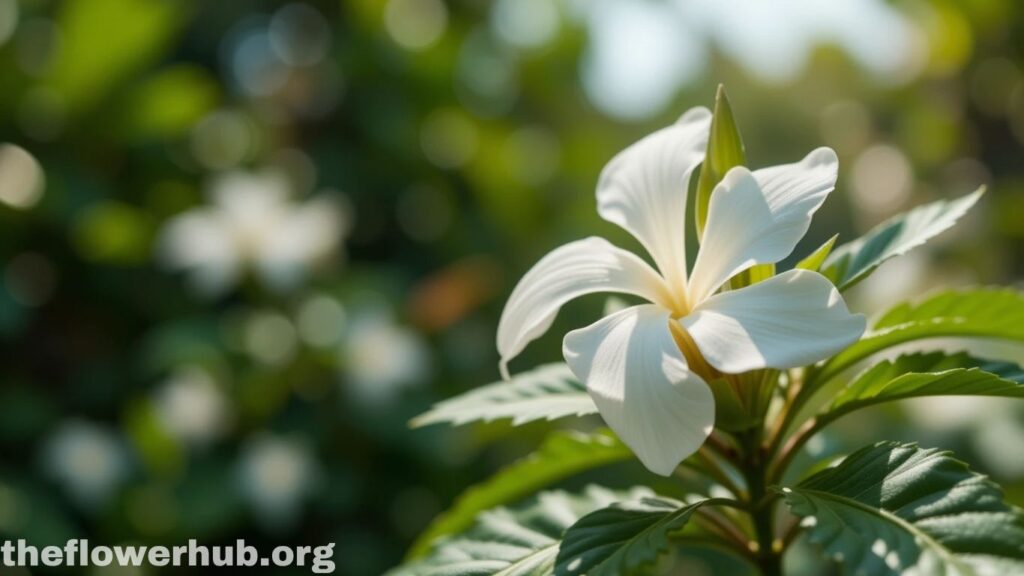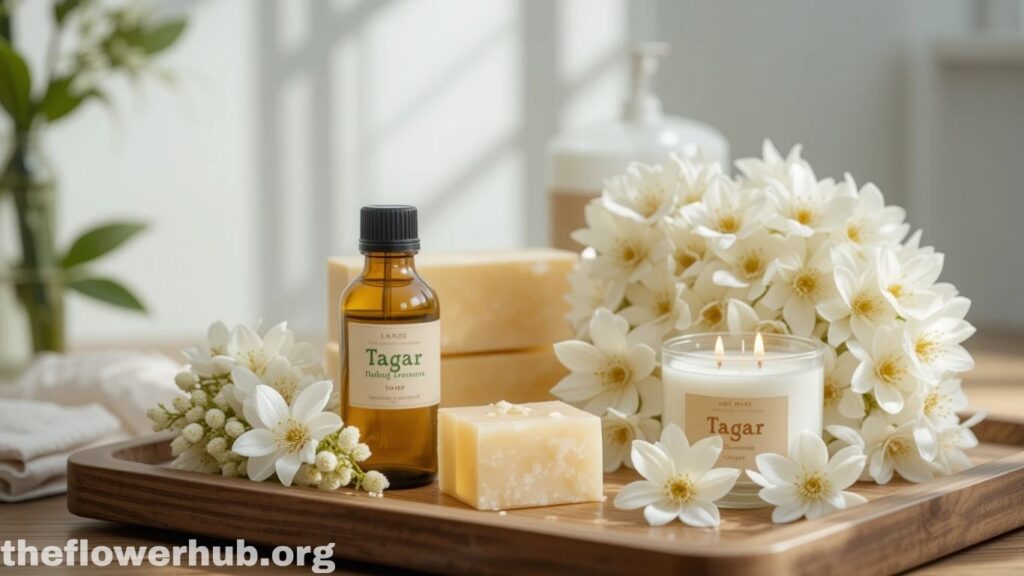Introduction
Tagar flower, Tabernaemontana divaricata, is an evergreen ornamental plant appreciated for his aesthetic appeal as well as for its cultural and medicinal importance. Native to mainly the tropical countries, India, Sri Lanka and South East Asia, Tagar is a creamy white flower that sometimes has a light smell, they are good for gardens, rituals and for herbal purposes.
If you are a gardening buff or even a professional botanist it has a lot to teach you and if you are fond of classic flowers this flower has a lot more in store for you. Our blog will take you on a journey through seven amazing facts about the flower — from its biology and Ayurvedic virtues to its symbolism and the natural functions it serves.

Table of Contents
Table: Overview
| Feature | Details |
|---|---|
| Botanical Name | Tabernaemontana divaricata |
| Common Names | Tagar, Crape Jasmine, Chandni, East India Rosebay |
| Family | Apocynaceae |
| Origin | India, Southeast Asia |
| Flower Color | White |
| Season | All year round in tropical regions |
| Climate | Warm, humid, tropical |
| Medicinal | Antiflammatory, antifungal, sedative |
| Symbolic Meaning | Purity, Spirituality, Calmness |
| Cultural Significance | Used in Hindu rituals and temple offerings |
Botanical Identification
The Tagar flower is a member of the large family of Apocynaceae flowering plants, known for their medicinal and ornamental properties. It is scientifically called Tabernaemontana divaricata or often mistaken for gardenia and jasmines because it looks so much like them. But what distinguishes the Tagar is its pinwheel shaped flowers, thick glossy leaves, and milky sap.
The plant is a small to medium shrub or small tree that will grow up to 6 feet. It does best in wet conditions, so is found in South Asian gardens.
Varieties of Tagar Flower
There are a number of subspecies of the Tagar flower which are characterised mainly by the shape and size of the flower.
- Single – Five petals, spirally arrangedResponseBodyBody Body forming a vase when complete, hollow and brittlebelongsTo Leadbelcher Profile4,250,000,000 (18%)The strong grey-blue bark covers a silvery luster.
- Tagar Double – Blooms like the petal of rose
- Miniature Tagar – narrow, tidy habit small enough for pots indoors.
These sub-species are suited to different horticultural purposes and are used in landscaping, home gardens, and sacred spaces.
Cultural and Religious Importance of Tagar Flowers
The Tagar flower has significant spiritual value in Indian civilizations. It is also available in temple yards and is consecrated to deities during the daily rituals and festivals.
Why is the Tagar flower Sacred?
- Symbol of Cleanliness: Its Clear White color speaks of purity of heart and of the world.
- Connected with Peace: Its tranquil aroma creates a meditative space.
- In Festivals: Tagar is widespreadly used during Ganesh Chaturthi and Navratri as a favored flower offering.
In Hinduism, white blossoms such as Tagar are considered favorites of the deities like Shiva and Vishnu, representing surrender and devotion.
Ayurvedic health benefits of Tagar flower
Tagar flower is widely used in the ancient system of medicine in India called Ayurveda. Its roots, leaves, and flowers are employed to cure numerous sicknesses.
Health Benefits of Tagar Flower
- Sedative Effects: Can be used to combat insomnia and stress.
- Anti-inflammatory: Used to heal injuries and reduce swelling.
- Anti-fungal and Antibacterial: Applied topically in recipe pastes for skin infections.
- Appetizer: Increases appetite and alleviates digestive disturbance.
- Nervine Tonic: Soothes the nervous system and improves brain function.
Gently use the decoction of Tagar in powdered form. But one should take the advice of a professional Ayurvedic doctor before its consumption.
Gardening and Cultivation Tips for Tagar Flower
The Tagar plant is easy to grow so it is a favourite of gardeners – both amateurs and professionals.
Ideal Growing Conditions
- Sunlight: Full sunlight to partial sunlight.
- Soil: Well drained, slightly acid soil is best.
- Irrigation: Needs regular watering but not over-watering.
- Fertilizer: Apply a balanced organic fertilizer each month to encourage flowering.
Propagation Methods
- Stem cuttings: Most popular & very effective.
- Layering: Very effective on bushier growth.
- Seeds: Less commonly used method and performs slower.
A well-nourished Tagar plant can flower all year round and have thick leaves that can last throughout the year.
Environmental Importance of Tagar Flower
More than just a symbolic beauty leading us out of winter, the Tagar flower also has a hidden impact on the local environment.
December Birth Flower: 5 Powerful Facts & Meaning Guide
Ecological Contributions
- Attracts Pollinators: The sweet fragrance attracts bees and butterflies to the garden helping to improve your pollination rates.
- Air Purification: Tagar plant, being from the tropical region is a good air purifier.
- Soil Stabilization The roots help stop erosion, particularly on areas of gardening bed with a slope.
Urban planners and landscapers commonly use Tagar shrubs in city parks and community gardens to provide these ecological services.
Legends and Symbols of Tagar Plant
Symbolic Meanings
- Love and Devotion: It’s a symbol of deep commitment in certain cultures.
- Inner Peace: Known to create a Peaceful environment in meditation areas.
- Ascension: Symbol of spiritual ascension and search for enlightenment.
Common Myths
- Myth: The bloom of Tagar occurs only in moon light.
- Reality: It looks stunning in moonlight but blooms during the daylight.
- Myth: It can protect you from evil spirits.
- Truth: This theory could originate from the fact that some people use white sage in religious ceremonies, but it is not scientifically true.
These legends contribute to the mystic aura of the Tagar flower, which allow this flower its cultural significance too.
Tagar Flower Commercial and Modern Uses
Tagar flower is used both in ayurveda as well as in rituals and ceremonies from ancient times and now a days in the industries such as:

Cosmetics and Perfumery
That fragile scent is now enshrined in:
- Perfume oils
- Scented soaps
- Aromatherapy products
Floral Arrangements
Used in:
- Wedding decorations
- Temple garlands
- Home decor
Essential Oil Extraction
Tagar oil, which is prepared from the roots and flowers, is often used in massage and wellness therapy.
FAQs
Q1: Is Tagar flower same as Jasmine?
No, they are in same but different plant family and has it’s own properties.
Q2: Is it possible to grow Tagar in pots?
Yes, in dwarf or miniatures used for container gardening particularly.
Q3: Which season is best for growing Tagar?
Best time to plant Tagar flower cutting is in early spring or in monsoon.
Q4: Can Tagar flower be eaten or are they used in food?
No, it is not used in cooking, nor should it be ingested.
Q5: Does Tagar have any side effects when used medicinally?
Yes, dizziness and drowsiness are among the most common reported uses for Zivadine Tablet. Always consult an expert.
Conclusion
The Tagar flower is not just a pretty little white bloom—it is a living symbol of tradition and healing, of ecological harmony. And its versatility makes it as potent in gardens and temples as it is in wellness environments. With its love for the soil and eternal medieval importance, the tagar flower blooms forever across places and periods.
Whether you are drawn to nature, fascinated by culture, or wish for natural healing, having the Tagar flower in your life could bring beauty, calm, and a small bit of ancient lore.
7 Fascinating Facts About Pussy Willow: Nature’s Soft Marvel
